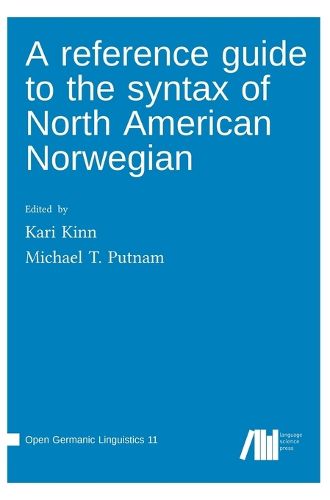Readings Newsletter
Become a Readings Member to make your shopping experience even easier.
Sign in or sign up for free!
You’re not far away from qualifying for FREE standard shipping within Australia
You’ve qualified for FREE standard shipping within Australia
The cart is loading…






This title is printed to order. This book may have been self-published. If so, we cannot guarantee the quality of the content. In the main most books will have gone through the editing process however some may not. We therefore suggest that you be aware of this before ordering this book. If in doubt check either the author or publisher’s details as we are unable to accept any returns unless they are faulty. Please contact us if you have any questions.
North American Norwegian (NAmNo) is a diasporic heritage variety of Norwegian spoken primarily in the Upper Midwest of the United States. NAmNo has been in use since the mid-19th century, but it is now moribund. This volume serves as a synopsis of previous research focusing on the syntax of this language while also expanding upon these findings in key domains. Beyond the rich empirical description of facets of North American Norwegian syntax, the chapters in this volume also contribute to theory-building efforts from a Minimalist perspective. Kari Kinn and Michael T. Putnam begin the volume introducing the language and the theoretical preliminaries of aspects of the Minimalist Program found throughout the volume. The introductory chapter is followed by a detailed history of the emigration and language during the settlement period by Arnstein Hjelde. Brita Ramsevik Riksem and Mari Nygard explore the intricacies of agreement in determiner phrases, while Yvonne van Baal investigates its properties of definiteness. Kari Kinn rounds out the contributions on aspects of determiner phrases by taking a closer look at how possession is licensed in these structures. Shifting focus to the verbal and clausal domains, Kristin Eide's chapter addresses the syntactic reflexes of tense, modality, and aspect in NAmNo. The structure of non-finite clauses is the theme of Michael T. Putnam and Ashild Softeland's contribution, which is followed up by Merete Anderssen, Helene R. Jensberg, Terje Lohndal, Bjoern Lundquist, and Marit Westergaard's treatment of verb second (V2) word and finite verb placement. Ida Larsson and Kari Kinn analyze argument placement in NAmNo, focusing particularly on subject shift, object shift, and verb particles. Michael T. Putnam and Kari Kinn conclude the volume with an epilogue, highlighting the key empirical and theoretical findings of these contributions as well as charting a course for future research on the syntax of NAmNo. In summary, this volume is the fi
$9.00 standard shipping within Australia
FREE standard shipping within Australia for orders over $100.00
Express & International shipping calculated at checkout
This title is printed to order. This book may have been self-published. If so, we cannot guarantee the quality of the content. In the main most books will have gone through the editing process however some may not. We therefore suggest that you be aware of this before ordering this book. If in doubt check either the author or publisher’s details as we are unable to accept any returns unless they are faulty. Please contact us if you have any questions.
North American Norwegian (NAmNo) is a diasporic heritage variety of Norwegian spoken primarily in the Upper Midwest of the United States. NAmNo has been in use since the mid-19th century, but it is now moribund. This volume serves as a synopsis of previous research focusing on the syntax of this language while also expanding upon these findings in key domains. Beyond the rich empirical description of facets of North American Norwegian syntax, the chapters in this volume also contribute to theory-building efforts from a Minimalist perspective. Kari Kinn and Michael T. Putnam begin the volume introducing the language and the theoretical preliminaries of aspects of the Minimalist Program found throughout the volume. The introductory chapter is followed by a detailed history of the emigration and language during the settlement period by Arnstein Hjelde. Brita Ramsevik Riksem and Mari Nygard explore the intricacies of agreement in determiner phrases, while Yvonne van Baal investigates its properties of definiteness. Kari Kinn rounds out the contributions on aspects of determiner phrases by taking a closer look at how possession is licensed in these structures. Shifting focus to the verbal and clausal domains, Kristin Eide's chapter addresses the syntactic reflexes of tense, modality, and aspect in NAmNo. The structure of non-finite clauses is the theme of Michael T. Putnam and Ashild Softeland's contribution, which is followed up by Merete Anderssen, Helene R. Jensberg, Terje Lohndal, Bjoern Lundquist, and Marit Westergaard's treatment of verb second (V2) word and finite verb placement. Ida Larsson and Kari Kinn analyze argument placement in NAmNo, focusing particularly on subject shift, object shift, and verb particles. Michael T. Putnam and Kari Kinn conclude the volume with an epilogue, highlighting the key empirical and theoretical findings of these contributions as well as charting a course for future research on the syntax of NAmNo. In summary, this volume is the fi